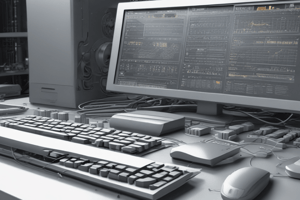Podcast
Questions and Answers
What is one primary reason organizations should adopt computer applications?
What is one primary reason organizations should adopt computer applications?
- To minimize employee training
- To eliminate all manual processes
- To manage digital information efficiently (correct)
- To prepare for the future workforce
Which characteristic of valuable information indicates that it should be free of errors?
Which characteristic of valuable information indicates that it should be free of errors?
- Accessible
- Flexible
- Accurate (correct)
- Complete
What does the 'Garbage in, Garbage out' principle primarily refer to?
What does the 'Garbage in, Garbage out' principle primarily refer to?
- The quality of output depends on the quality of input (correct)
- The benefits of data storage
- The need for data security
- The importance of software applications
Which of the following best defines 'information' in the context of the content?
Which of the following best defines 'information' in the context of the content?
What does 'economical' refer to regarding valuable information?
What does 'economical' refer to regarding valuable information?
Which characteristic of valuable information allows it to serve multiple uses?
Which characteristic of valuable information allows it to serve multiple uses?
What is a characteristic that indicates information should include all essential facts?
What is a characteristic that indicates information should include all essential facts?
What role do information systems play in organizations?
What role do information systems play in organizations?
Which of the following accurately describes the focus of upstream management in a value chain?
Which of the following accurately describes the focus of upstream management in a value chain?
What is a primary challenge in global information systems management related to infrastructure?
What is a primary challenge in global information systems management related to infrastructure?
Which force is NOT part of the five-forces model for identifying competitive advantage?
Which force is NOT part of the five-forces model for identifying competitive advantage?
When considering the risks of new information systems, what is a common consequence of failure?
When considering the risks of new information systems, what is a common consequence of failure?
Which of the following is an example of a downstream management activity in the value chain?
Which of the following is an example of a downstream management activity in the value chain?
What is a key advantage of Liquid Crystal Displays (LCD) compared to CRTs?
What is a key advantage of Liquid Crystal Displays (LCD) compared to CRTs?
Which device typically uses plotters for output?
Which device typically uses plotters for output?
What should be inspected to verify a laptop's physical integrity?
What should be inspected to verify a laptop's physical integrity?
Which internet connection type is considered the slowest due to its inability to support broadband?
Which internet connection type is considered the slowest due to its inability to support broadband?
Which connector is commonly associated with transmitting video and audio signals?
Which connector is commonly associated with transmitting video and audio signals?
What type of system is designed to manage a company's operations across multiple locations?
What type of system is designed to manage a company's operations across multiple locations?
Which of the following is a nonvolatile memory technology?
Which of the following is a nonvolatile memory technology?
Which of the following is a characteristic of management information systems?
Which of the following is a characteristic of management information systems?
What feature is NOT typically evaluated when buying a desktop computer?
What feature is NOT typically evaluated when buying a desktop computer?
What type of wireless connection is commonly used for short-range communication?
What type of wireless connection is commonly used for short-range communication?
Which technology utilizes a connection similar to a phone line for internet access?
Which technology utilizes a connection similar to a phone line for internet access?
Which term best describes business transactions executed electronically between businesses?
Which term best describes business transactions executed electronically between businesses?
Which of the following factors is important to check regarding a laptop's performance?
Which of the following factors is important to check regarding a laptop's performance?
What is a primary function of transaction processing systems?
What is a primary function of transaction processing systems?
Which of the following systems focuses on providing aid in decision-making for managers?
Which of the following systems focuses on providing aid in decision-making for managers?
Which internet connection type is delivered wirelessly to a receiver?
Which internet connection type is delivered wirelessly to a receiver?
What is the primary focus of enterprise systems?
What is the primary focus of enterprise systems?
Which of the following best defines knowledge management systems?
Which of the following best defines knowledge management systems?
What role do expert systems play in organizations?
What role do expert systems play in organizations?
What is a characteristic of artificial intelligence in business?
What is a characteristic of artificial intelligence in business?
How does virtual reality differ from immersive virtual reality applications?
How does virtual reality differ from immersive virtual reality applications?
Which of the following is NOT a component of device support systems?
Which of the following is NOT a component of device support systems?
What is the main purpose of transaction systems?
What is the main purpose of transaction systems?
Which of these is a characteristic of specialized business information systems?
Which of these is a characteristic of specialized business information systems?
Flashcards are hidden until you start studying
Study Notes
Why Businesses Should Adopt Computer Applications
- Businesses frequently deal with digital information, making digital tools crucial.
- Information systems can cut costs and boost profitability.
- Information systems collect, manipulate, store, and distribute data and information.
- They provide feedback to achieve specific objectives.
Information Concepts
- Data is raw facts, including alphanumeric, image, audio, and video data.
- Information is organized data, providing additional value beyond its individual components.
- Knowledge is the application of information to make informed decisions.
Characteristics of Valuable Information
- Accessible: Information must be readily available by authorized users in the appropriate format at the right time.
- Accurate: Information needs to be free of errors.
- Complete: Information should include all relevant facts.
- Economical: Producing information should be cost-effective, considering the information's value.
- Flexible: Information should be usable for various purposes.
Information System (IS):
- A collection of interrelated components that collect, manipulate, store, and disseminate data and information.
Storage Devices
- CD-ROM: Stores several gigabytes of data.
- DVD: Stores 5 times more data than a CD-ROM.
- Blu-ray: Stores significantly more data than a DVD.
- Flash Memory: Nonvolatile silicon computer chips.
Output Devices
- Printers: Laser or inkjet printers.
- Plotters: Designed for general design work.
Laptop Buying Tips
- Inspect for physical damage to ports.
- Check battery usage, display, drives, hard drive, memory, modem, network card, processor, sound card, video card, weight, service, upgrade options, and warranty.
Desktop Buying Tips
- Inspect for physical damage.
- Check the case, CD media, hard drive, memory, network card, processor, sound card, video card, return policy, service, upgrade options, and warranty.
Wired Device Connectors
- VGA Cable: Used for video connections.
- HDMI Cable: High-definition multimedia interface for audio and video transmission.
- Ethernet Cable: Used for wired network connections.
- Audio Cable: For sound transmission.
- USB Cable: Universal Serial Bus for data transfer and device connection.
Common Short-Range Wireless Connections
- Bluetooth: Wireless communication technology for short distances.
- Infrared: Uses light waves for data transmission over short distances.
Types of Internet Connections
- Cable: Uses similar cables to cable TV services.
- DSL: Uses phone lines for a digital connection.
- Satellite: Wireless connection to a receiver.
- Dial-up: The slowest connection type, using traditional phone lines.
Measuring Internet Speed
- Online speed test: Websites for testing internet speed.
- Ping: Measures the time it takes for a network signal to travel from one point to another, reflecting network responsiveness.
Implementing Internet-Based Applications
- Application/Information System: Software that manages data and functions.
- Internet Connection: Connection to the internet.
- Host (Server): The computer that stores and distributes the application.
- Domain (Internet ID): Unique address for the application/website.
Business Information Systems
- Commonly used in organizations to manage business processes.
- Examples include electronic/mobile commerce systems, management information systems, decision support systems, and specialized business information systems.
Electronic and Mobile Commerce
- E-Commerce: Electronic transactions between parties, including:
- B2B: Business-to-business.
- B2C: Business-to-consumer.
- C2C: Consumer-to-consumer.
- C2G: Consumer-to-government.
Enterprise Systems
- Business-related exchanges (e.g., payments to employees, sales to customers, payments to suppliers).
Transaction Processing System (TPS)
- A collection of people, procedures, databases, software, and devices used to record completed business transactions.
Enterprise Resource Planning (ERP)
- Integrated programs that manage a company's business operations across multiple locations. Coordinates planning, inventory control, production, and ordering.
- Examples: SAP, Oracle, Netsuite, Microsoft Dynamics.
Management Information Systems (MIS)
- Collection of people, procedures, databases, software, and devices.
- Provides routine information to managers and decision-makers.
- Focuses on operational efficiency.
Decision Support Systems (DSS)
- Collection of people, procedures, databases, software, and devices.
- Provides support for problem-specific decision-making.
- Emphasis is on decision-making effectiveness.
Specialized Business Information Systems
- Knowledge Management Systems: Collection of people, procedures, databases, software, and devices to create, store, share, and use organizational knowledge and experience.
Virtual Reality
- Simulation of real or imagined environments experienced visually in three dimensions.
- Immersive virtual reality: Fully immersive experiences.
- Non-immersive applications: Partially immersive experiences.
- Virtual reality is valuable for communication, entertainment, and learning.
Artificial Intelligence (AI)
- Field where computer systems exhibit human-like intelligence.
Expert Systems
- Computer systems that provide expert-level suggestions and actions in specific fields.
- Allow organizations to capture and utilize expertise from specialists.
- Knowledge base: Contains data, rules, procedures, and relationships crucial for achieving value or desired outcomes.
System Development
- The process of creating, implementing, and maintaining information systems.
Value Chain
- A series of activities encompassing inbound logistics, warehouse storage, production, finished product storage, outbound logistics, marketing and sales, and customer service.
Upstream Management
- Management of raw materials, inbound logistics, and warehouse/storage facilities.
Downstream Management
- Management of finished product storage, outbound logistics, marketing and sales, and customer service.
Global Challenges in Information Systems
- Cultural Challenges: Cultural differences can impact how information systems are used.
- Language Challenges: Language barriers can hinder communication and understanding.
- Time and Distance Challenges: Time zone differences and geographical distances can create coordination issues.
- Infrastructure Challenges: Adequate technology infrastructure is necessary for information systems to function effectively.
- Currency Challenges: Exchange rates and currency fluctuations can impact financial transactions.
- Product and Service Challenges: Differences in needs and preferences can impact the development and implementation of information systems.
- Technology Transfer Issues: Transferring advanced technology from developed to developing countries can face obstacles.
- State, Regional, and National Laws: Legal frameworks and regulations vary across countries, impacting information systems development.
- Trade Agreements: International trade agreements can affect information system development and implementation.
Factors That Lead Firms to Seek Competitive Advantage
- Porter's Five Forces: This model identifies key factors influencing competition in an industry, including:
- Rivalry among Existing Competitors: Competition among existing firms in the industry.
- Threat of New Entrants: New competitors entering the industry.
- Threat of Substitute Products and Services: Availability of alternative products or services.
- Bargaining Power of Buyers: The power of customers to influence prices and terms.
- Bargaining Power of Suppliers: The power of suppliers to influence prices and terms.
Risk
- Managers must consider the risks involved in designing, developing, and implementing information systems.
- Information Systems Failure: The potential for information systems to fail.
- Development and Implementation Costs: Costs of developing and implementing new or modified information systems could exceed the returns.
Studying That Suits You
Use AI to generate personalized quizzes and flashcards to suit your learning preferences.



